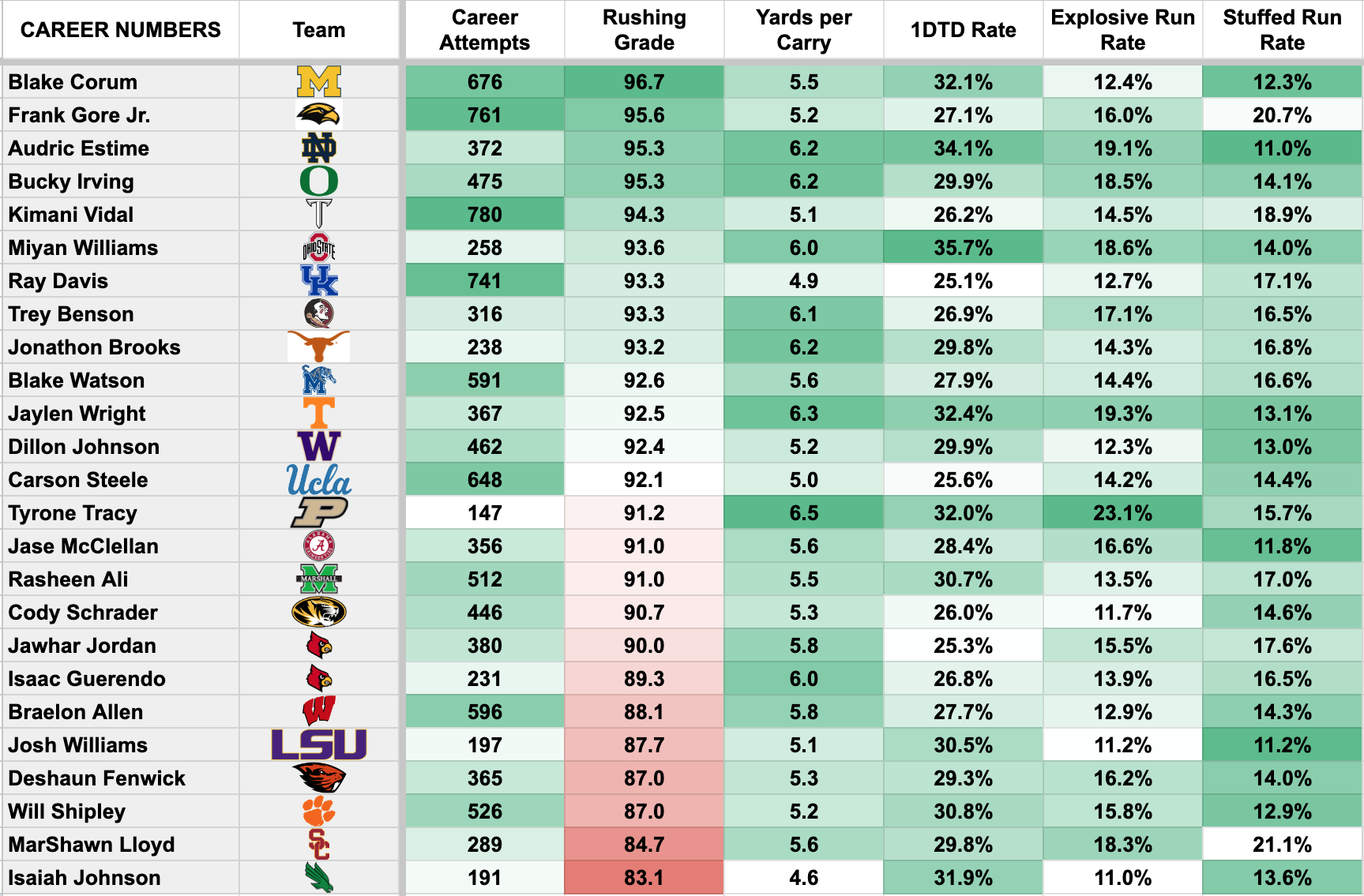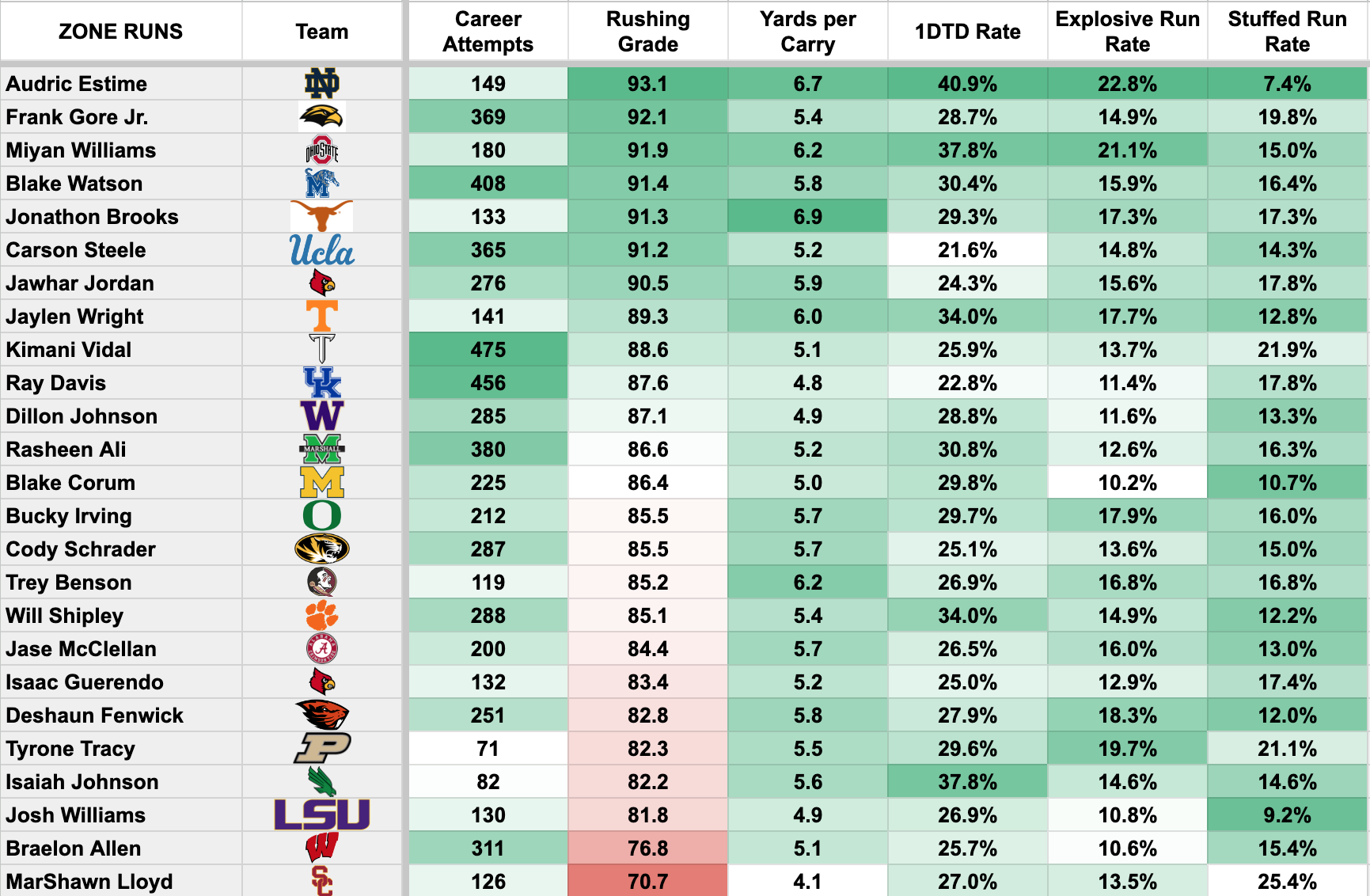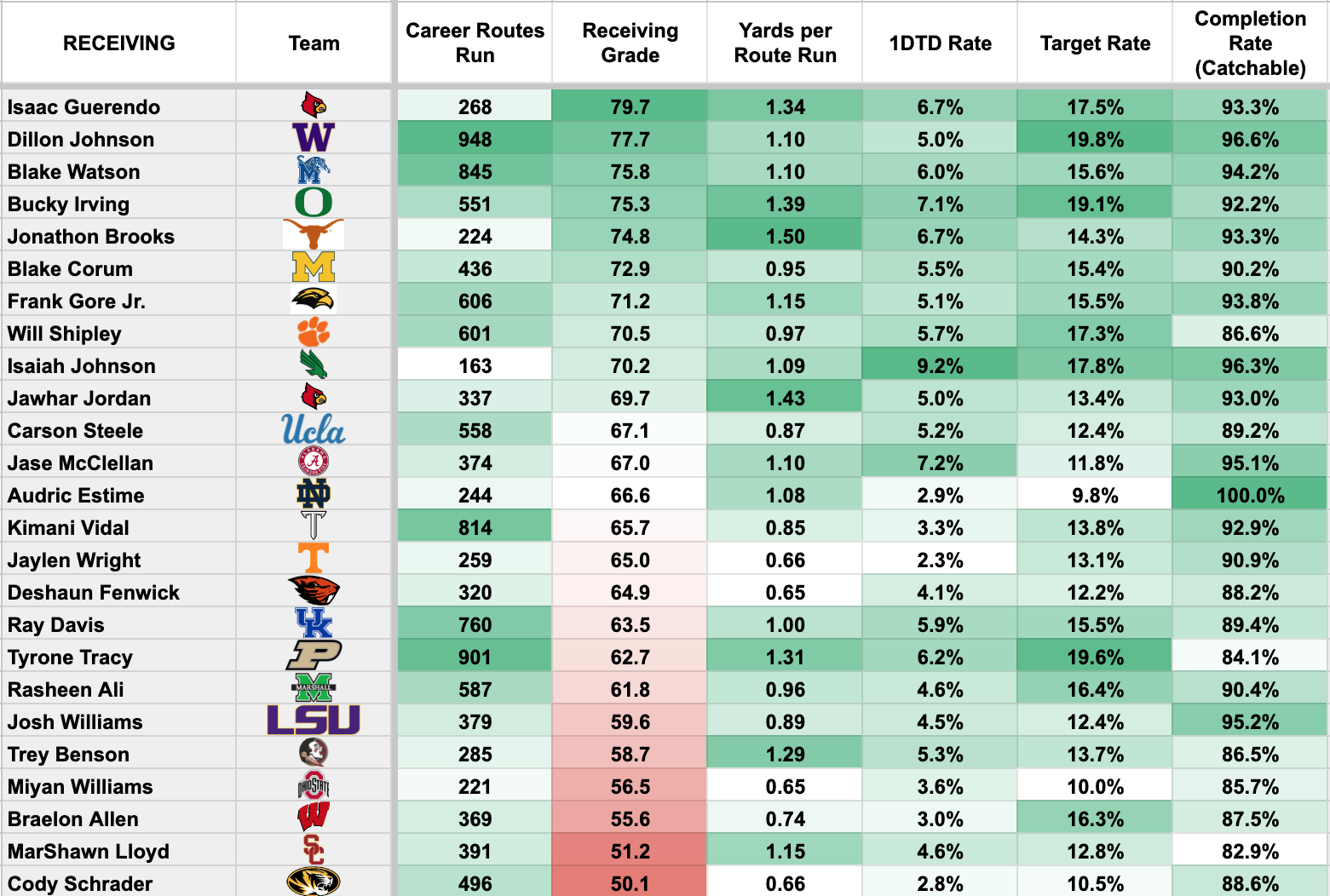• How each back performed against stacked boxes: Audric Estime and Blake Corum are excellent at generating positive runs, even when the defense is ready for them.
• The most effective backs by run concept: See which FBS running back prospects performed better from zone and gap-scheme run concepts.
• Draft and trade for yourself: Try PFF's Mock Draft Simulator — trade picks and players and mock for your favorite NFL team.
Estimated Reading Time: 8 minutes
Click here for more draft tools:
2024 Mock Draft Simulator | 2024 Big Board | 2024 Draft Guide
2024 Player Profiles | 2024 Mock Drafts | NCAA Premium Stats
The 2024 NFL Draft gets closer by the day and there can never be enough data to pore over when evaluating prospects. Beginning with the running backs, this piece will focus on how the top prospects in this year’s draft performed in key situations, helping us better understand their usage and production in college.
We will focus on a lot of metrics that are not readily available through PFF Premium Stats to give an exclusive in-depth breakdown. Some notes:
- Only FBS running backs will be included in this analysis.
- Career attempts is how many carries each running back had in the specific situations highlighted.
- Rushing grade is each running back's PFF rushing grade from within each specific situation.
- Yards per carry is how many rushing yards each running back totaled divided by their number of carries in each specific situation.
- 1DTD rate is the number of times a running back delivered a first down or touchdown on their attempts within each specific situation.
- Explosive run rate is the number of times a running back ran for 10 or more yards on a play in each specific situation.
- Stuffed run rate is the number of times a running back was tackled at or behind the line of scrimmage within each specific situation.
Overall Career Rushing Numbers

Starting with the basics, this is an overview of how each FBS running back performed in the more typical metrics across all situations during their college career.
Michigan’s Blake Corum — a top-three prospect on the PFF big board — owns the highest career rushing grade in this class, and one of the highest among all running back prospects since 2018, as is highlighted here. Corum isn't the most explosive runner, nor does he stand out in certain stable metrics, such as missed tackles forced per attempt, but he consistently delivers positive runs and avoids being taken down at or behind the line of scrimmage.
Notre Dame’s Audric Estime will be a repeat name at the top of many of these lists, performing well on his opportunities and delivering one of the best first-down-plus-touchdown rates while also maintaining a low stuffed run rate.
Career Numbers Versus Stacked Boxes (8-plus defenders)

Here, we highlight the prospects who performed well when the defense was playing to defend the run. These players produced positive outcomes despite facing a situation less conducive to success.
Estime owns the highest career rushing grade of this year’s draft class, and of all running backs since 2018, when facing an eight-man box. His rushing grade and strong explosive run rate are testaments to his ability to create space for himself while also limiting negative plays.
Corum appears near the top again in overall rushing grade while still posting a below-average explosive run rate. His ability to create positive runs regardless of the situation is going to be a desirable trait, despite his not having a high-end playmaking ceiling.
Texas running back Jonathon Brooks is the top-ranked running back on the PFF big board. He was a one-year starter, so his sample size is relatively small, but there are concerns here about how he produced against stacked boxes. His rushing grade sits below average and his stuffed run rate is the worst mark of the class in those situations.
Career Zone Run Concept Numbers

Inside- and outside-zone runs are the most common rushing concepts in the NFL, so being able to understand those schemes and deliver on them is going to be important early in these running backs’ NFL careers.
Estime leads the group once again in rushing grade for this category, delivering the best rate of first downs and touchdowns as well as posting the best stuffed run rate. His case as a “sleeper” in this year’s class continues to grow as we learn more about his production.
Frank Gore Jr. has performed well in PFF’s grading system with a significant workload to back it up. His feel for both zone and gap-scheme run concepts is evident in his tape and rushing grade for each. Much like with Michigan’s Corum, he lacks the big-play upside due to speed concerns. He also has plenty of runs that go nowhere, as he struggles to create those positive plays at the same rate as Corum, for example.
Career Gap-Scheme Run Concept Numbers

Counter and power runs are the most common gap-scheme rushing concepts in the NFL, and are quite different from typical zone runs in that there is at least one pulling blocker to follow toward the point of attack. This often means running backs will have to show patience and know how to take advantage of the holes that their offensive lineman create.
Once again, Corum stands tall at the top, having more experience with these gap-scheme concepts than any other back in this class. As a result, he delivered a high success rate and continued to be an overall positive on his many career touches, regardless of the situation.
Oregon’s Bucky Irving took on a decent workload across both rushing schemes, though he was significantly better on gap scheme runs for his college career.
Career Goal-to-Go Numbers

Goal-to-go situations are key for fantasy managers, as this is where the majority of rushing touchdowns come from. The offense’s ability to get into these situations is a big contributing factor, as well as the team’s choice of who to deploy. But generally, how the running back performs in these opportunities is particularly telling regarding their usage going forward.
No running back in this class saw more touches around the goal line than Corum, and as a result, he delivered more career touchdowns (58) than any back in the class.
Troy’s Kimani Vidal performed well in key rushing metrics, enough to put him in sleeper consideration, though one of those strengths wasn’t around the goal line. Despite being given plenty of opportunities in goal-to-go situations, Vidal wasn’t quite as effective with his opportunities, seeing an above-average stuffed run rate and a below-average first-down-plus-touchdown rate.
Career Early-Down (1st and 2nd) Numbers

First and second downs are where most rushing attempts come, so it’s also going to be important to identify those who have the most success on those key rushing downs.
A lot of the names remain the same at the top, including Corum, Irving and Estime. Gore and Vidal also return with their above-average workloads and concerning stuffed run rates.
Some other names on the PFF big board, including Jonathon Brooks, Jaylen Wright, Trey Benson and Ray Davis, performed well on early downs with strong rushing grades.
USC’s Marshawn Lloyd — the seventh-ranked running back prospect on the PFF big board — appears near the bottom on many of these specific rushing categories and again here on early downs. Lloyd’s career rushing grade isn’t strong relative to this class, and his 20% stuffed run rate isn’t going to help in that regard. For a player with great speed and explosiveness, there’s a lot of boom-or-bust to his numbers here.
Career Late-Down (3rd and 4th) Numbers

While early downs represent the large majority of running back work, there are still going to be opportunities on later downs, and being able to move the chains on those plays becomes all the more important for this group.
Jonathon Brooks and Marshawn Lloyd own the lowest rate of first downs plus touchdowns in these key situations. The sample size is relatively low for the two, but their success rates are still slightly concerning. For Brooks, there’s less of a concern, considering his 8.1 yards per carry and that the majority of his late-down carries often came in long-distance situations.
Career Receiving Numbers

Lastly, receiving usage and production will be key for any running back class, as success in this area of their game can lead to a larger chance of earning an every-down role.
Louisville’s Isaac Guerendo has been a hot name following a dominant combine that included a 4.33-second 40-yard dash time. Guerendo’s small sample of work as both a rusher and receiver can be concerning, and while he didn’t perform particularly well throughout the rushing categories, it’s at least promising that he did so as a receiver. Considering his speed and limited experience as a starter, there may be a role for him as a receiving-down back if he lands in the right situation.




 © 2025 PFF - all rights reserved.
© 2025 PFF - all rights reserved.